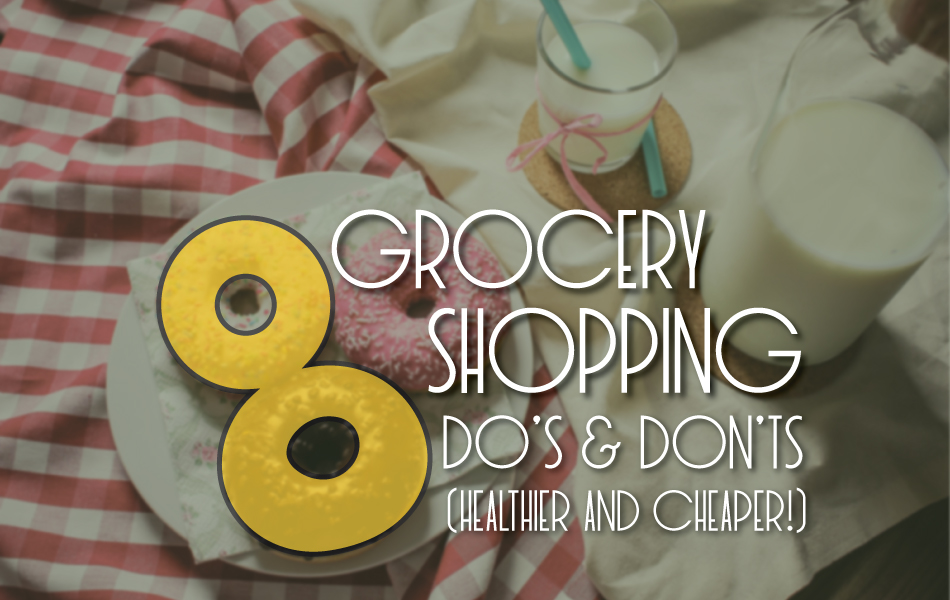Total Therapy Blog

8 Do’s and Don’ts for Healthier (and Cheaper!) Grocery Shopping
 This post was written by our Registered Dietitian, Kirstie Hilverda.
This post was written by our Registered Dietitian, Kirstie Hilverda.
I have loved food and experimenting in the kitchen since I was a little girl, which lead me to pursuing a career as a dietitian. My goal is to help others embrace food as a way to nourish our bodies and our souls. When it comes to nutrition counselling, I emphasize personalized client-focused care because nutrition looks a little different for everyone! I also advocate for an evidence-based approach, so your treatment is based on science – not fad diets or the latest food trend.
Because I’m such a foodie, my free time is often spent experimenting in the kitchen, trying new restaurants, and perusing food blogs. I also love spending time hiking in the mountains, rock climbing, running, and cozying up with a good book.
Okay, you get it – you eat what you buy … or what you put in your cart, you put in your mouth … or … something like that. Here are 8 Do’s and Don’ts to keep in mind to get the most out of your next grocery trip.
1. DO have a plan in mind. DON’T wander around aimlessly.
 Having a grocery list helps you be efficient with your time, stay focused on what you need, and avoid buying foods that will get left in the bottom of the fridge to rot. (Food waste is both expensive and depressingly unnecessary.) It’s also helpful to do your shopping after a snack, or at least well before your next meal. Roaming the supermarket while you’re hungry leaves you vulnerable to buying anything everything you’re craving. Making a plan might involve taking a few minutes to write out what you’d like to eat over the course of the week, and, lucky you, that’s another strategy to keep yourself on track!
Having a grocery list helps you be efficient with your time, stay focused on what you need, and avoid buying foods that will get left in the bottom of the fridge to rot. (Food waste is both expensive and depressingly unnecessary.) It’s also helpful to do your shopping after a snack, or at least well before your next meal. Roaming the supermarket while you’re hungry leaves you vulnerable to buying anything everything you’re craving. Making a plan might involve taking a few minutes to write out what you’d like to eat over the course of the week, and, lucky you, that’s another strategy to keep yourself on track!
2. DO understand your staples. DON’T buy small quantities of everyday items over and over again.
Understanding your staple foods gives you permission to be confident about buying items in bulk and taking advantage of sales. Instead of buying the tiniest bag of oatmeal/rice/beans/frozen berries because that’s all you’ll eat over the course of a week, commit to the larger bag and save yourself some serious $$$. These types of things aren’t likely to go bad very quickly, so it’s worth it to think about dollar-value over the long-term.
3. DO stick to the perimeter. DON’T get sucked into fancy packaging.
Most of the time, foods located around the perimeter are some of my favourite kinds of foods – those with just one ingredient. Hello! Produce, meats, fish, eggs, milk, yogurt, and cheese are all A+. Once you get further into the middle of the grocery store, foods tend to be more processed and packaged, which isn’t necessarily bad, but it is something to be mindful of. Great essentials that ARE found further into the middle of the store include dried beans and legumes, rice and other grains, bulk nuts and seeds, spices, and canned vegetables and fruits.
4. DO be aware of what’s in season. DON’T ignore where your food comes from.
 Making an effort to learn about what’s in season makes you a conscious consumer, which is always good. I am a strong advocate of encouraging others to learn more about where their food comes from. Purchasing fruit and vegetables that are in season often means that you have an option to choose something that is grown locally, which, most of the time, is less expensive AND nicer for our farmers and our planet. Plus, there’s something so satisfying about stopping at roadside veggie stands and going berry-picking.
Making an effort to learn about what’s in season makes you a conscious consumer, which is always good. I am a strong advocate of encouraging others to learn more about where their food comes from. Purchasing fruit and vegetables that are in season often means that you have an option to choose something that is grown locally, which, most of the time, is less expensive AND nicer for our farmers and our planet. Plus, there’s something so satisfying about stopping at roadside veggie stands and going berry-picking.
5. DO consider the generic store brand for non-perishable goods. DON’T assume the name brand is higher quality.
 Generally speaking, a fancier label and a steeper price does not mean the contents will be better tasting or more nutritious. Take a quick peek at nutrition labels and ingredient lists. These unbiased parts of the label are more likely to help you make smart decisions.
Generally speaking, a fancier label and a steeper price does not mean the contents will be better tasting or more nutritious. Take a quick peek at nutrition labels and ingredient lists. These unbiased parts of the label are more likely to help you make smart decisions.
6. DO choose a less processed option. DON’T try to eliminate processed foods.
The concept of “eliminating processed foods” is one I hear quite often. The actual practice of doing this seems next to impossible if you’re being literal about the word processed. Healthy foods like oatmeal, dried lentils, chickpeas, milk, and roasted almonds all require some degree of processing before they reach the supermarket. That being said, if there is a LESS processed option of something that you’d like to buy, go for that one. For example, when you’re looking at yogurt, you’re better off picking the one with an ingredient list that looks more like “milk, active bacterial cultures” than the one that reads “skim milk, sugar, corn starch, water, gelatin, preservative, colour, fruit” …you get my gist?
7. DO try something new every once in a while. DON’T get in a rut of buying broccoli, chicken breast, and brown rice every week. Unless you like it. Even then.
Ah, the quintessential healthy meal. Broccoli, chicken breast, and brown rice are all great, but if they’re the starts of every lunch and dinner, you’re probably going to get bored of them. It’s trite, but true: variety is the spice of life. You’re more likely to be successful with healthy eating goals if you switch things up regularly. Try committing to picking out a new veggie each week – you never know what might be a new favourite!
8. DO watch out for health claims like “natural,” “organic,” “gluten-free,” “soy-free,” “vegan.” DON’T assume a food is healthy because it has one of these phrases and a bright green label on it.
 I don’t mean to be too sassy with this one (okay, maybe a little), but it’s important to note that, most of the time, labels and health claims are really just labels and health claims. For people with allergies (i.e. soy, milk), health conditions (i.e. celiac-disease), or ethically-founded diets (vegan, vegetarian), these labels can be very important. For the average joe roaming the grocery store, they are probably more confusing than helpful. Just because your cupcake is a gluten-free, dairy-free, vegan cupcake, does not mean that it’s healthier for you. It COULD be, but I haven’t seen the label. ;) Read labels, educate yourself, and if you can, just eat the cupcake you’ll enjoy more.
I don’t mean to be too sassy with this one (okay, maybe a little), but it’s important to note that, most of the time, labels and health claims are really just labels and health claims. For people with allergies (i.e. soy, milk), health conditions (i.e. celiac-disease), or ethically-founded diets (vegan, vegetarian), these labels can be very important. For the average joe roaming the grocery store, they are probably more confusing than helpful. Just because your cupcake is a gluten-free, dairy-free, vegan cupcake, does not mean that it’s healthier for you. It COULD be, but I haven’t seen the label. ;) Read labels, educate yourself, and if you can, just eat the cupcake you’ll enjoy more.
——–
If you want more tips and tricks to get the most out of your next grocery trip, invite me along! I provide grocery store tours. Call (604) 620-9700 to schedule a free consultation with me, and learn if this service could work for you!
For more expert ideas about how to get the most out of your healthy eating resolutions, stay tuned for another nutrition-focused article next Friday!








Follow Us!
& Stay Up To Date
BLOG